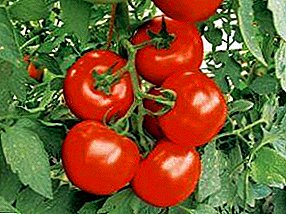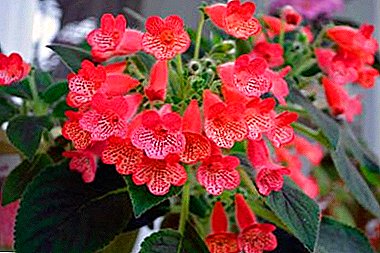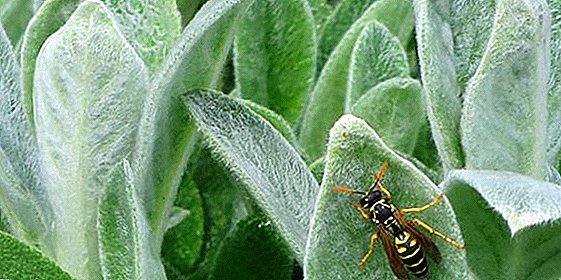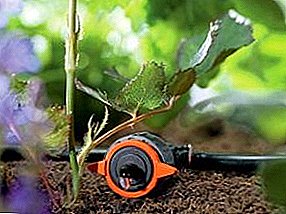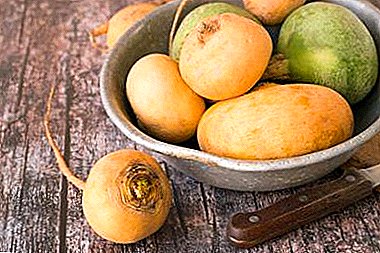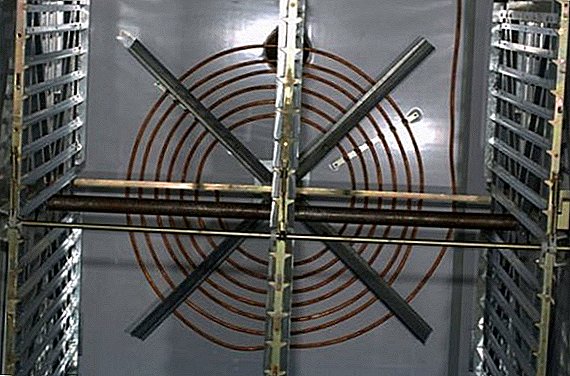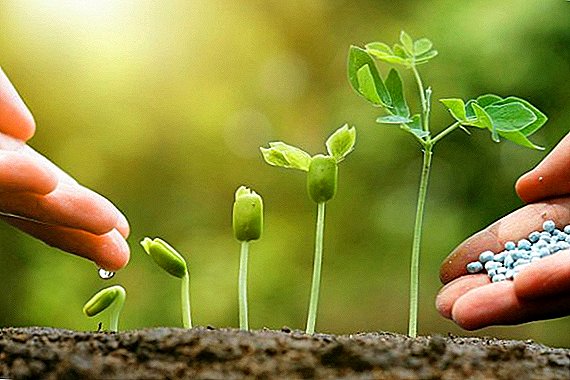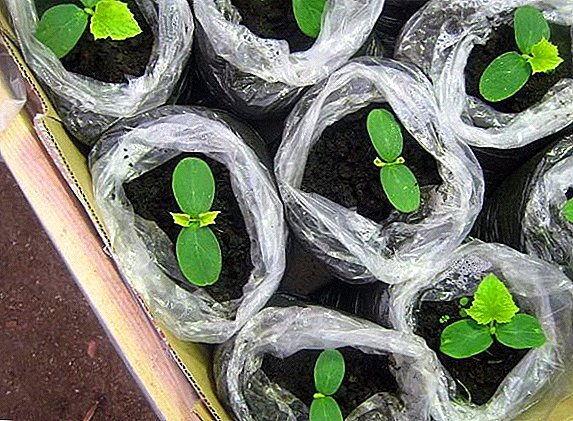 On what tricks the summer residents do not go for the sake of obtaining a rich and high-quality crop of vegetables in a seedling way. There are many methods of growing seedlings at home for the purpose of their further transplantation to a permanent place of growth, but comparatively recently they began to talk about another: growing seedlings in diapers. What is this method and how profitable such a decision will be - we will try to understand the article.
On what tricks the summer residents do not go for the sake of obtaining a rich and high-quality crop of vegetables in a seedling way. There are many methods of growing seedlings at home for the purpose of their further transplantation to a permanent place of growth, but comparatively recently they began to talk about another: growing seedlings in diapers. What is this method and how profitable such a decision will be - we will try to understand the article.
Seedlings in diapers
Immediately it is worth making a reservation that in this case it is not a question of standard calico or flannelette baby diapers, although the way the plants are placed resembles the wrapping of a child. For country needs use polyethylene material, such that often cover the greenhouse or simply planted on the site of culture.
In some situations, in the role of a diaper for the same tomatoes or cucumbers use ordinary transparent sachets, size 20x30 cm, however, in this case it is not always possible to vouch for the quality of the seedlings. Consider all the pros and cons of such a decision. 
Let's talk about the pros
Of course, when choosing one or another method of growing plants, any summer resident will be interested in the benefits that he will receive as a result of such a decision, so for a start we will consider the merits of the diapering method. These include:
- significant savings in space even at the stage of seeding;
- saving nutrient substrate;
- the possibility of multiple use of the film (it can grow seedlings at least every year, and then wash, dry and leave until next season);
- fencing of seedlings from possible diseases transmitted through the soil (for example, the famous black leg);
- ease of controlling seed germination, which is especially important when using last year's planting material;
- convenience of picking young plants;
- the possibility of applying the method as a fallback, when when grown by traditional methods, something went wrong.
Important! In the diaper, you can try to germinate even the oldest seeds, since in such conditions they are more likely to slip, and even if it does not work out, then it is not terrible, because you will not incur any losses.

Are there any disadvantages?
Speaking about the merits of nursing diapers, it would be unfair not to discuss the shortcomings of their use. First of all, it is necessary to consider the following nuances:
- when grown in this way, the plants do not receive the required amount of light, as a result they lag behind in development from seedlings planted in cups and placed on window sills;
- with good growth of the stems, the root system develops rather weakly;
- Not all plants will be able to stay in "shirts" for a long time, some of them will need to be transplanted into separate containers soon after germination.
Interesting ways of growing plants on hydrogel, hydroponics, beds of pyramids, vertical beds, in buckets,
Growing methods
There are three possible options for planting seeds in film "shirts", but the main element of each of them is the same plastic film.  You can purchase it at the hardware store or use last year's covering material from the greenhouse, and in extreme cases you can find the most suitable waste package. The rest of the conditions for the implementation of such landings will be discussed further.
You can purchase it at the hardware store or use last year's covering material from the greenhouse, and in extreme cases you can find the most suitable waste package. The rest of the conditions for the implementation of such landings will be discussed further.
Did you know? The largest seeds in the world are the seeds of fruits growing on fan palm tree lodoitsey. The tree was discovered by Europeans in 1742 and it was about that time that they found out that its fruits, on average, weigh about 12–16 kg.
With germinated seeds
If you are going to use this method, it means that you will need properly prepared seed of tomatoes, cucumbers, peppers, cabbage, eggplants or any other vegetables, as well as appropriate inventory in the form of a film, prepared substrate, basin or a spacious box.
The soil most suitable for the crop you are going to grow is suitable for the role of an optimal soil mix. In addition, for the convenience of labeling varieties planted in film, it is also worth preparing a marker and paper tape or medical plaster.
The technology of planting germinated seeds, in this case, involves the following actions: 
- prepare and germinate seed selected for the cultivation of the culture;
- we cut the film in such a way that the individual pieces correspond in size to the tetrad sheet;
- In the upper left corner of the polyethylene film, spread on a spoon of a slightly moistened, prepared in advance substrate;
- on top of the ground place the sprout, and so that its cotyledon leaves protrude beyond the upper part of the material;
- on top we cover the sprout with a spoonful of moistened soil;
- we bend the bottom of the film and roll the material in a circle, so that the result is a twisted roll;
- we fix our tube with an elastic band (the stationery is best suited);
- we place the seedlings in prepared containers, very tightly to each other.
Did you know? According to research by archaeologists, the first to pay attention to tomatoes and the possibility of their deliberate cultivation were the Incas and Aztecs, who, without any “diaper”, successfully cultivated plants in the 8th century BC.
Without soil
This variant of growing seedlings is probably the most economical of all the ones listed in the article. All that you need in addition to seeds of tomatoes, cucumbers or other crops that, by the way, do not need preliminary germination, is a film, toilet paper and small containers in the form of disposable plastic cups, scraps of bottles or cans.
True, stationery gum will also be useful (they usually hold money together), growth stimulants, a spray gun, and a marker with scotch to indicate planted varieties. In this case, on one small window sill hundreds of seedlings can fit.
The technology of planting seedlings in diapers without using soil provides for the following tasks: 
- the film is cut into strips with a width of 10 cm;
- Toilet paper is laid on top of each piece and slightly moistened with a spray bottle, using ordinary water or diluted plant root formation stimulator;
- one centimeter should be pulled back from the top edge and spread out the seeds in 2-4 cm increments for a tomato (for larger seeds, for example, cucumber seeds, the step increases);
- on top of the seeds cover with another layer of toilet paper, and on top of it lay a diaper strip;
- the whole structure is twisted into a roll and fixed with an elastic, but not very tightly, because the seedlings need enough space;
- in the prepared container it is necessary to pour water, and so much so that a diaper of 1-2 cm is enough for immersion, because rising up, the liquid will begin to nourish the seeds.
Did you know? Polyethylene is used not only to create today's convenient bags, but also is a raw material for sewing fashionable clothes. Such shows are organized in the framework of special shows, trying to attract public attention to the preservation of nature. It is sometimes difficult to believe that the outfit you like is made of plastic bags.
Substrate use
This option of planting seedlings in many ways resembles the previous method, and the difference is that the film is left right up to the dispatch of the grown crops to the permanent place of their growth. In this case, it is possible to achieve a good result due to the use of a small amount of substrate, and it is not necessary to wait for the shoots in the film roll, because the seedlings of seedlings can be transplanted on films after picking.
In this case, the disembarkation of seedlings in a diaper occurs according to the following scenario:
- the same ten centimeter long strips are cut from the film, as in the previous version;
- the substrate is sprayed with water from a spray bottle and, if desired, will be placed on top of toilet paper, which, however, does not have to be done;
- seeds or dive seedlings are planted in the soil, adhering to a step of 4-5 cm;
- from above, planting material is covered with a small amount of soil mixture and moistened with it;
- As the next layer, toilet paper is again used, which is covered with a film strip on top;
- The resulting sandwich needs to be carefully rolled up into a roll, then place all the "strands" on the pan prepared in advance.
 In this case, the planted plants will occupy a little more space than in the previous version (the presence of soil increases the thickness of the rolls), but less than in the first. In such a state, the seedlings will be able to calmly wait for a transplant to a garden bed or to a greenhouse, only with an early disembarkation it will be necessary to additionally protect them with film cover from possible spring frosts.
In this case, the planted plants will occupy a little more space than in the previous version (the presence of soil increases the thickness of the rolls), but less than in the first. In such a state, the seedlings will be able to calmly wait for a transplant to a garden bed or to a greenhouse, only with an early disembarkation it will be necessary to additionally protect them with film cover from possible spring frosts.Proper care of seedlings grown diaper method
Successful planting of seeds by the diaper method is only the first step towards obtaining a bountiful and high-quality crop. The next responsible task will be to organize the proper care of the seedlings, which provides timely feeding, watering, ensuring sufficient lighting and permanent removal of condensate accumulating on the film.
Frequent (several times a week) the introduction of nutrient formulations based on humic acids is intended to compensate for the lack of soil, but given the need to fertilize the newly emerged seedlings, the concentration of the solution needs to be reduced by half.
Also, do not pour the plants with water, because the film material retains moisture very well, which is why the frequency of fluid application is reduced. This is especially true of plantations, additionally covered on top of the film. If condensate builds up on it, it must be removed regularly. In addition, it is likely that if there is a lack of lighting, you will have to use artificial sources of daylight, occasionally turning on lamps over the plants.
In addition, it is likely that if there is a lack of lighting, you will have to use artificial sources of daylight, occasionally turning on lamps over the plants.
Seedlings obtained by growing in the manner described above, simply dive. Just need to pick up the bundles and having considered exactly where the roots are located, move them 2-3 cm upwards, then cut off the bottom with a knife. Of course, the film will suffer, but quick picks are worth such sacrifices. Carefully taking out the young plants, they are also carefully seated in separate containers or in small diapers.
From diaper to soil
No matter how successful you may find the solution of picking seedlings from film to diapers, it is better to transfer the grown seedlings immediately to the open ground. If there is a greenhouse on the dacha, then there will be no problems with early disembarkation and possible cold snaps, but if you have to plant the plants directly into the ground, then the beds must be additionally protected from the cold.
A good solution would be to create a bird feather pillow under the topsoil (you can cut the old pillow), paper, sawdust or hay. They will warm the still weak seedlings from below, while under the threat of significant cold snaps, they are covered with plastic or plastic bottles on top.  When growing cucumbers, they are sometimes covered with burdocks.
When growing cucumbers, they are sometimes covered with burdocks.
Absolutely all the above options for growing seedlings in diapers will significantly save space, soil and your personal time, and some experts call them the perfect solution for lazy and economical summer residents. Suppose that at the initial stages of cultivation such seedlings seem weaker than the specimens grown in pots or boxes, but if you comply with all the requirements for care, they will bring no less yield.
Tomatoes and cucumbers from diapers: features of growing
Despite the almost identical technology of growing different crops, the requirements for diaper structures for each of them may have their own individual differences. It is easy to verify this by considering the nuances of such cultivation of tomatoes and cucumbers.
In the first case, for growing in apartment conditions, only seeds of determinant varieties and hybrids can be used, sowing them in the middle or closer to the end of March. Do not leave seedlings for too long in diapers, since the optimal period for them in tomatoes is 45 days. This method of cultivation is not suitable if the summer resident wants to get a harvest from indeterminant hybrids, because the normal formation of brushes is disturbed in the film.
For example, a hybrid Typhoon F1 is characterized by the presence of a smooth brush on which fruits are neatly arranged, and if you try to grow a plant in diapers, then with high probability you can talk about the beginning of its branching into two or three processes. True, even in this case, many summer residents manage to get a fairly good harvest.
Important! When reproducing, transporting and picking up tomato seedlings, it must be remembered that sudden temperature changes are a huge stress for the plants, therefore, before performing these actions, treat them with special homeopathic remedies like "Healthy Garden". They will be able to minimize the negative impact.If we are talking about growing cucumbers on the plot, then we should remember about the need for preliminary germination of seeds. To do this, planting material is simply soaked in a plastic pot with several layers of toilet paper laid on the bottom, previously moistened with water. After a few days the seeds will have the first shoots.
Before placing cucumber seed directly into the ground, you can simply pour water over it, then put it into the prepared substrate, scooping it with a spoon and trying to keep the roots intact. In the ground, a small depression is made with a stick or simply with a finger, and then seeds are poured into it (one for each hole).
Usually, the planting of cucumbers, as well as squash or pumpkins, is carried out in mid-April, although much in determining the specific dates depends on the region of residence. If you are in the middle lane, you put a container with seedlings in the greenhouse, then the first shoots can be expected in 3-5 days.
Important! So that the soil does not spill out of the selected container, you can lay a layer of sacking on the bottom of the box or basin.Today there is already a lot of evidence of the success of the process of growing seedlings in diapers, and carefully following all the requirements for planting and further care for different crops, you will get good and strong plants that can bring high-quality and abundant crops.


